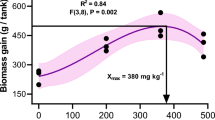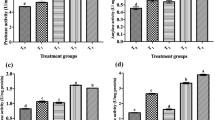Abstract
A 45-day feeding trial was conducted to evaluate the effects of dietary citric acid on growth, digestive enzyme and disease resistance of white shrimp, Litopenaeus vannamei. Shrimp with initial body weight of 5.57 ± 0.21 g were fed with basal diet supplemented with 0.0 g kg−1 (control), 1.0, 2.0, 3.0, 4.0 and 5.0 g kg−1 citric acid. Results showed that weight gain was increased by 15.9 % and feed conversion ratio was decreased by 0.17 by 2.0 g kg−1 dietary citric acid compared with control group (P < 0.05). Intestinal protease activity of shrimp fed 2.0 g kg−1 citric acid was significantly higher (P < 0.05) than that of control group. No significant difference was found in intestinal amylase activity among treatments (P > 0.05). The activities of serum phenoloxidase, superoxide dismutase and lysozyme in 2.0 and 3.0 g kg−1 citric acid group were significantly higher, and accumulative mortalities of the two groups on the fourth day after injection of Vibrio alginolyticus were significantly lower than those of control group (P < 0.05). Results above demonstrated that dietary citric acid could improve growth performance, immunity and resistance against V. alginolyticus. The supplementation level of citric acid in diet was suggested to be 2.0–3.0 g kg−1 for white shrimp.

Similar content being viewed by others
References
Adrián JH, Shuichi S, Viswanath K (2012) Supplementation of citric acid and amino acid chelated trace elements in low-fish meal diet for rainbow trout affect growth and phosphorus utilization. J World Aquacul Soc 43(5):688–696
Agustín B, Agustín V, Ignacio A, Carmen C, Manuel P, Carmen B (2003) The effect of citric acid and microbial phytase on mineral utilization in broiler chicks. Anim Feed Sci Technol 110:201–219
AOAC International (1999) Official Methods of Analysis, 16th edn. Association of Official Analytical Chemists International, Maryland
Ashida M, Soderhall K (1984) The prophenoloxidase activating system in crayfish. Comp Biochem Physiol 77:21–26
Boling SD, Snow JL, Parsons CM, Baker DH (2001) The effect of citric acid on the calcium and phosphorus requirements of chicks fed corn-soybean meal diets. Poult Sci 80:783–788
Bruno CS, Felipe NV, José LPM (2013) Salts of organic acids selection by multiple characteristics for marine shrimp nutrition. Aquaculture 384–387:104–110
Cho CY, Slinger SJ, Bayley HS (1982) Bioenergetics of salmonid fishes: energy intake, expenditure and productivity. Comp Biochem Physiol 73B:25–41
Divakaran S, Ostrowski A (1990) Enzymes present in pancreatic extracts of the dolphin Corphaena hippurus. J World Aquacul Soc 21:35–39
Gauthier R (2002). Intestinal health, the key to productivity: The case of organic acids. XXVII Convencion ANECA-WPDC, Puerto Vallarta Jal Mexico 1-14
Gauthier R (2005) Organic acids and essential oils, a realistic alternative to antibiotic growth promoters in poultry. Animal World 148-157
Gedek B, Roth FX, Kirchgessner M (1993) Influence of fumaric acid, hydrochloric acid, sodium formate, tylosin and toyocerin on the microflora in different segment of the gastrointestinal tract. Pig News and Information 14:178
Holmblad T, Soderhall K (1999) Cell adhesion molecules and antioxidative enzymes in a crustacean possible role in immunity. Aquaculture 172:111–123
Hultmark D, Rasmusnt S (1980) Insect immunity: purification and properties of three inducible bactericidal proteins from hemolymph of immunized pupae of Hyalophera cecropia. Eur J Biochem 106:7–16
Khajepour F, Hosseini SA (2012a) Citric acid improves growth performance and phosphorus digestibility in Beluga (Huso huso) fed diets where soybean meal partly replaced fish meal. Anim Feed Sci Technol 171:-68-73
Khajepour F, Hosseini SA (2012b) Calcium and phosphorus status in juvenile Beluga (Huso huso) fed citric acid-supplemented diets. Aquac Res 43(3):407–411
Knarreborg A, Miquel N, Granli T, Jensen BB (2002) Establishment and application of an in vitro methodology to study the effects of organic acids on coliform and lactic acid bacteria in the proximal part of the gastrointestinal tract of piglets. Anim Feed Sci Technol 99:131–140
Koo IC, Ohol YM, Wu P, Morisaki JH, Cox JS, Brown EJ (2008) Role for lysosomal enzyme β-hexosaminidase in the control of mycobacteria infection. Proc Natl Acad Sci USA 105:710–715
Lambert PJ, Stratford M (1999) Weak acid preservatives: modeling microbe inhibition and response. Appl Microbiol 86:157–164
Leng XJ, Lun F, Li XQ, Wang ZQ, Xu KJ (2006) Effects of citric acid on growing performance and nutrients digestibility of allogynogenetic crucian carp. J Shanghai Fish Univ 15:178–182
Li JS, Li JL, Wu TT (2005) Effects of non-starch polysaccharides enzyme, phytase and citric acid on activities of endogenous digestive enzymes of tilapia (Oreochromis niloticus × Oreochromis aureus). Aquac Nutr 15:415–420
Li JP, Shan AS, Cheng BJ, Chen ZH (2009) Effects of Schisandra Chinesnsis and citric acid on serum biochemical indices a immune function of weaned pigs. Chin J Anim Sci 45:25–29
Lim C, Lückstädt C, Klesius PH (2010) Review: use of organic acids, salts in fish diets. Glob Aquac Advocate 5:45–46
Ma SY (2002) Effect of citric acid on performance and blood indexes of broilers. Cereal Feed Ind 8:31–33
Mroz Z, Jongbloed AW, Partanen K, Vreman K, Van Diepen JThM, Kemme PA, Kogut J (1997) The effect of dietary buffering capacity and organic acid supplementation (formic, fumaric or n-butyric acid) on digestibility of nutrients (protein, amino acids, energy and minerals), water intake and excreta production in growing pigs. Report JD-DLO 97:65
Øverland M, Granli T, Kjos NP, Fjetland O, Steien SH, Stokstad M (2000) Effect of dietary formates on growth performance, carcass traits, sensory quality, intestinal microflora and stomach alterations in growing-finishing pigs. J Anim Sci 78:1875–1884
Øverland M, Kjos NP, Borg M, Skjerve E, Sørum H (2008) Organic acids in diets for entire male pigs: effect on skatole level, microbiota in digesta, and growth performance. Livest Sci 115:169–178
Pan Q, Tan YG, Bi YZ, Zheng SX (2004) Effects of citric acid on growth, whole body composition and activities of digestive enzymes in hybrid tilapia Oreochromis niloticus × O. aureus. J Fish Sci Chin 11:344–348
Pandey A, Satoh S (2008) Effects of organic acids on growth and phosphorus utilization in rainbow trout Oncorhynchus mykiss. Fish Sci 74:867–874
Partanen KH, Mroz Z (1999) Organic acids for performance enhancement in pigs. Nutr Res Rev 12:117–145
Partanen KH, Siljander-Rasi HT, Suomi K, Fossi M (2002) Performance of growing-finishing pigs fed medium or high-fibre diets supp Alaviuhkola lemented with avilamycin, formic acid or formic acid–sorbate blend. Livest Prod Sci 73:139–152
Qi ZZ, Zhang XH, Boon N, Bossier P (2009) Probiotics in aquaculture of China: current state, problems and prospect. Aquaculture 290:15–21
Radecki SV, Juhl MR, Miller ER (1988) Fumaric and citric acids as feed additives in starter pig diets: effect on performance and nutrient balance. J Anim Sci 66:2598–2605
Sarker SA, Satoh S, Kiron V (2005) Supplementation of citric acid and amino acid-chelated trace element to develop environment-friendly feed for red sea bream, Pagrus major. Aquaculture 248:3–11
Sugiura SH, Gabaudan J, Dong FM, Hardy RW (2001) Dietary microbial phytase supplementation and the utilization of phosphorus, trace minerals and protein by rainbow trout (Oncorhynchus mykissWalbaum) fed soybean-meal based diets. Aquac Res 32:583–592
Tan CG, Li XQ, Leng XJ, Su XG, Chen L, Liu B, Ma F, Cai XQ, Guo T (2014) Effects of supplemental azomite in diets on growth, immune function and disease resistance of white shrimp (Litopenaeus vannamei). Aquac Nutr. doi:10.1111/anu.12081
Vielma J, Ruohonen K, Lall SP (1999) Supplemental citric acid and particle size of fish bone-meal influence the availability of minerals in rainbow trout Oncorhynchus mykiss (Walbaum). Aquac Nutr 5:65–71
Washington C, Dankert JR (1997) Phenoloxidase specific activity in the red swamp crayfish procambarus clarkia. Fish Shellfish Immun 7(5):289–295
Xie B, Yu KJ (2007) Shrimp farming in China: operating characteristics environmental impact and perspectives. Ocean Coast Manag 50:538–550
Xie XL, Hu YH, Ling L (2010) Inhibitory kinetics of citric acid on β-N-acetyl-D-glucosaminidase from prawn (Litopenaeus vannamei). Fish Shellfish Immun 29:674–678
Zhao ZY, Yin ZX, Weng SP, Guan HJ, Li SD, Xing K, Chan SM, He JG (2007) Profiling of differentially expressed genes in hepatopancreas of white spot syndrome virus-resistant shrimp (Litopenaeus vannamei) by suppression subtractive hybridization. Fish Shellfish Immun 22:520–534
Acknowledgments
This study was supported by Shanghai Municipal Agricultural Commission (No. 2009-6-6), Shanghai aquatic fishery key project (No. Y1101).
Author information
Authors and Affiliations
Corresponding author
Rights and permissions
About this article
Cite this article
Su, X., Li, X., Leng, X. et al. The improvement of growth, digestive enzyme activity and disease resistance of white shrimp by the dietary citric acid. Aquacult Int 22, 1823–1835 (2014). https://doi.org/10.1007/s10499-014-9785-3
Received:
Accepted:
Published:
Issue Date:
DOI: https://doi.org/10.1007/s10499-014-9785-3




